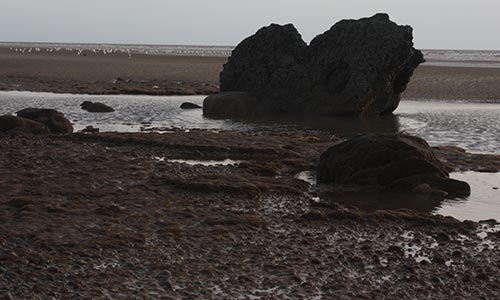BARRY McCANN looks at fascinating story of the fabled submerged village of Singleton Thorpe reputedly near Blackpool in Lancashire

The Lancashire port town of Fleetwood, standing on the Fylde coast just north of Blackpool, was until recent times a thriving harbour for North Sea trawlers.
However, there remains a superstition among fishermen that would return them immediately to portside if the bells of Singleton Thorpe church were heard tolling.
Why this was considered an ill omen? Because Singleton Thorpe was swallowed by the sea centuries before and the bells be tolling beneath the waves.
Singleton Thorpe is said to be a village that stood off the present north shore of Blackpool, during a time when the coastline stretched two miles further out to sea and was largely forested. It boasted a hostelry called the Penny O’ Pint, built next to a natural formation known as the Pennystone Rocks, where travellers tethered their horses with iron hooks.
According to local legend, it was during the reign of Bloody Mary that the village was swept away during one night in 1554 or 1555 (though some accounts suggest 1570) by a massive insurgence of the sea. The cause was possibly volcanic or other seismic activity – what would now the termed a tsunami – and the village disappeared beneath the waves forever. Apart from the underwater church bells, it is said that the racket of phantom carousers at the Penny O’ Pint can be heard on tempestuous nights.
Folk stories of submerged villages are be found around most shores of the UK, dating from times when sea levels were lower and the country was covered in trees. With only sketchy evidence to suggest Singleton Thorpe even existed, how much truth in its story?
Maps from before the late 1500s indicate the North West coastline from south Lancashire up to Carlisle near the Scottish border did stretch out a mile or two further than today. A total of 12 villages that stood along this peninsula were said to have been destroyed when a Tsunami hit the coast one fateful night around 1554/55.
One of them was Kilgrimol near Lytham St Annes from which no one survived. But legend has it that during the years that followed, the submerged graveyard of Kilgrimol church deposited coffins of decaying bodies on the beach after a storm disturbed their graves and they rose to the surface.
However, there are indications another of these villages, Waddam Thorp which stood off Blackpool’s south shore, was actually destroyed by a tidal wave in 1532, which points to number irruptions of the sea taking place over a number of years. Or was it more simply a steady erosion from which the inhabitants gradually evacuated?
The Victorian Antiquarian, William Thornber, claimed that Singleton Thorpe was swept away overnight and its survivors fled inland to set up a new village, simply called Singleton, which stands to this day. But this Singleton estate is listed in the Domesday Book – which dates it back to at least 1066 – while “Thorpe” suggests an offshoot settlement from it. However, it can also be pointed out that Singleton is derivative of “Shingle Village,” which suggests its foundation on a shingle beach, which then may have later extended inland.
So what of the physical evidence? The fabled Pennystone Rocks still stand on Blackpool’s north beach, though there are no signs of any iron hooks having been attached to them, or of any adjoining village. Excavations, however, have revealed the presence of tree trunks which confirms a forest did stand there.
Further north off the coast of Cleveleys, however, there have been uncovering’s of an ancient forest in the shifting sands. A cobbled road has also been sighted on the beach at Rossall Point, between Cleveleys and Fleetwood, where an expedition of 1893 went digging during Neap tide (lowest of the year) and discovered rafters of a large room, a doorpost and lintel, and the foundations of a wall.
So Singleton Thorpe may well have existed, just a little further north from where traditionally thought and not centred on the Pennystone Rocks. It also seems likely that is was little more than a small collection of cottages or farm, rather than a full village complete with an Inn and bell ringing church… unless there is more under those submerged sands than have yet been found. And if they ever are, maybe archaeologists will finally ascertain as to whether it came to a destructive end, or was simply abandoned to a gradually eroding sea.
Until then, the truth concerning the sea tombed village remains shrouded in mystery and speculation. But should you ever be sailing around the Fylde coast as the waves crash wildly… Listen out for that church bell.








Being a local man born and bread and having a reasonable knowledge of local history.ln the mid nineteen seventies my pal and I used to fish the local coast off Fleetwood. One day on a low water spring we walked to the lune bank .we came across a set stone causeway covered in kelp.shore ward of this were two round posts sticking from the sand.around 3or 4 feet in height for many years we spoke of this place and were ridiculed.